| dc.description.abstract | The objective of the study was to determine relations between toddler cognition and maternal perinatal iron and zinc biomarker levels; toddler cognition and infant Visual Information Processing (VIP); and toddler cognition and maternal dietary iron and zinc intake. The current project is a follow up to a study, which analyzed the relation between maternal micronutrient levels and infant cognition for breastfed infants (n = 132). The current study included mother/toddler pairs (n = 36) when toddlers were 2.5 to 4 years old (mean = 3.16). At three months postpartum multiple maternal iron indicators and zinc levels were measured, and mothers completed a Dietary History Questionnaire to measure dietary iron and zinc intake. Infants completed the VIP procedure at three and nine months old. Toddler cognition was determined by multiple measures, including the Pearson Picture Vocabulary Test, a Distractibility activity, and an Imitation task. At the toddler visit, mothers completed the MacArthur Bates Communicative Development Inventory (CDI) Mothers� mean total dietary iron and zinc intake met the Estimated Average Requirement. Descriptive statistics showed mothers were well nourished with serum zinc levels and multiple measures of iron within the recommended range except for increased soluble transferrin receptors (sTfR). Results for the first hypothesis indicated positive relations for maternal sTfR and toddler Distractibility (Total Looking Time) (p=0.042) and for maternal hemoglobin (Hgb) and CDI Vocabulary (p=0.036) and Mean Length of Utterance (MLU) (p=0.014). The other two hypotheses, toddler cognition and infant VIP as well as toddler cognition and maternal dietary iron and zinc were not supported. In conclusion, different pools of maternal iron, but not zinc, impacted specific domains of toddler cognitive development. Maternal Hgb, which reflects oxygen carrying capacity, was positively related to toddler language development. Increased maternal sTfR, which indicates decreased iron status, was related to increased toddler distractibility. The research indicated generally adequate maternal iron levels in healthy mothers impacted long-term development in healthy toddlers. Since maternal iron levels were positively significantly related to toddler cognitive development, the results support the Fetal Origins Hypothesis. | |
